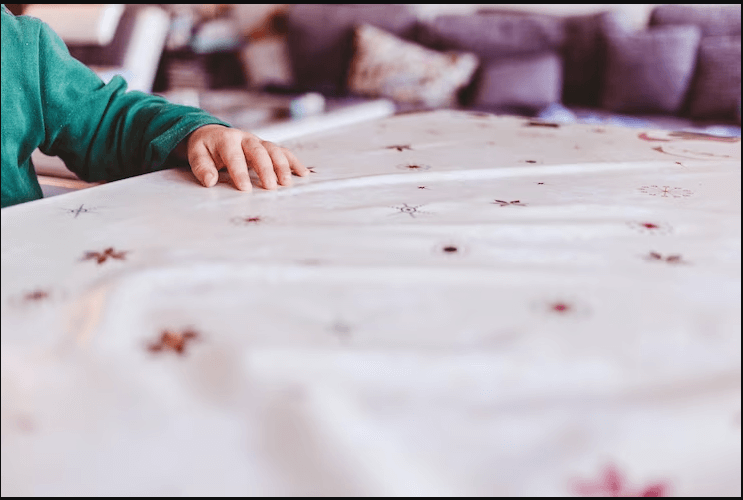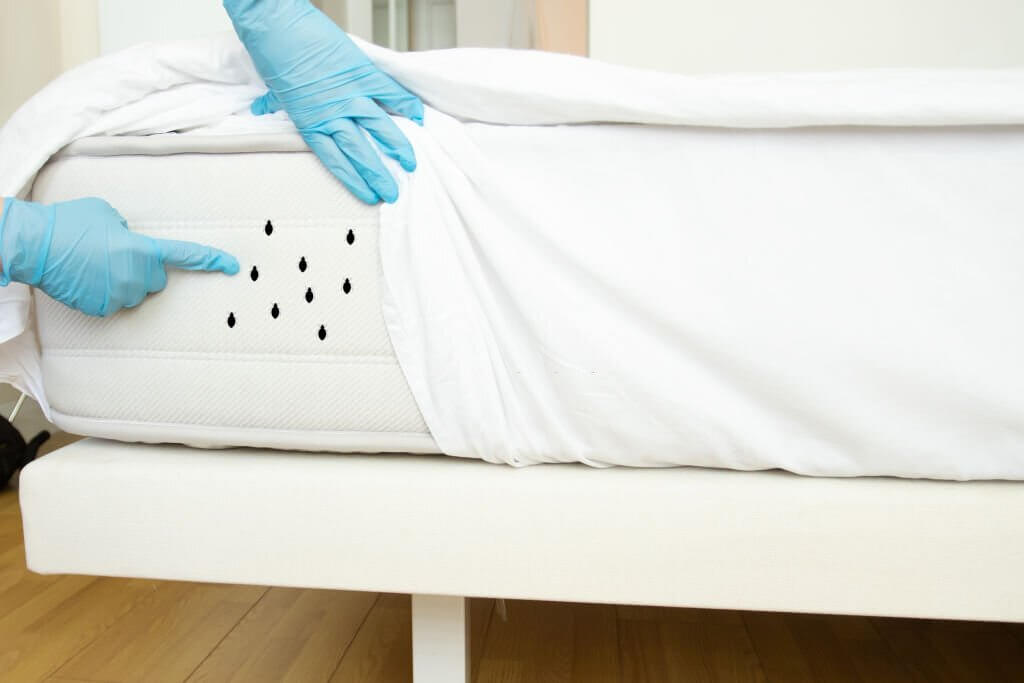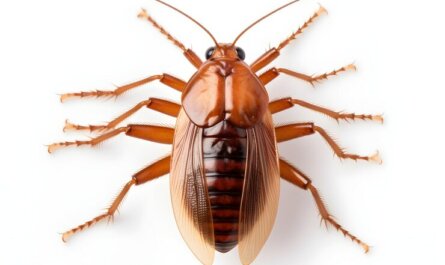Bed bugs can be an extremely unpleasant problem–especially when they hide in furniture like a couch. Did you know that one way to detect if there are bed bugs on your couch is by listening for clicking sound when pushing down? In this blog article, we’ll cover the signs of bed bug infestation and offer tips on how to get rid of them from your sofa safely and effectively.
So let’s explore different methods to help you protect your home from these pesky bugs!
How to Check for Bed Bugs in a Couch
Inspect the seams and crevices of your furniture for insect remains or fecal stains, and remember to turn the couch upside down for a thorough inspection.
Examine the seams and crevices
Inspecting the seams, tufts, and crevices of furniture is important to identify a bed bug infestation as they’re often found hidden in these areas. As many homeowners, renters, landlords, pest control professionals, parents and travelers know cluttered or dark places such as under cushions or in fabric folds provide an ideal hiding place for bed bugs.
To make sure you are not bringing a serious infestation into your home while traveling or buying second-hand furniture pieces it is essential to search for signs of activity like fecal stains or dark spots on the couch before bringing it inside.
Check for insect remains or fecal stains

Checking for insect remains or fecal stains can be an effective way to detect signs of bed bug infestation in a couch. Homeowners, Renters, Landlords, Pest Control Professionals, Parents, Travelers, People living in urban areas, Individuals with allergies or sensitivities and Second-hand furniture buyers should all inspect their couches for these signs before settling into them.
- Carefully examine the seams and crevices of the furniture where bed bugs may hide.
- Look for any insect remains such as live bugs or shed skins that may indicate a pest problem exists.
- Inspect behind cushions and inside folds for dark spots; these may be bed bug feces which appear like dark red stains on the surface of the fabric.
- Look for smear marks anywhere on the sofa; these are streaks of fecal material left when a bed bug crawls across a surface while cleaning itself.
- Use a strong flashlight if necessary to see deeper into the crevices of the furniture where bed bugs can hide away from sight.
- Turn over the furniture and look underneath it for any activity as this is another common area where bed bugs may congregate.
- Consider using a magnifying glass to help identify any potential signs more easily , especially if you do not have direct experience with identifying pests or insect excrement before .
Turn over the furniture
When searching for evidence of bed bugs in a couch, turning over the furniture is an effective way to get a thorough inspection. This allows individuals to check for signs of bed bug activity that may not be as visible when the furniture stays upright. Byturning over the furniture, it is easy to examine and inspect all areas on any couch or chair especially underneath and around the legs where bed bugs commonly hide.
Signs of Bed Bug Infestation in a Couch
Be on the lookout for visible bed bugs or eggs, musty odor, and dark spots on the couch.
Visible bed bugs or eggs
Visible bed bugs and eggs are the most obvious signs of a couch infestation. Bed bugs often hide in cracks, crevices, upholstery seams, tufts, buttons and other places where it’s dark and hard for humans to spot them.
Adult bedbugs typically measure about 5 mm in length with rusty-red colored bodies. As for their eggs, they are tiny in size— around 1mm— translucent yellowish-white color and can be found attached to furniture or fabrics using sticky glue secreted before hatching.
Other signs of couch infestation include fecal spots on The fabric or mattress surface which may appear as black/brown clusters; musty odor caused by pheromones; blood stains from crushed bed bug carcasses; cast skins left over during molting stages not to mention bites near your shoulder or waistline if you unknowingly slept on an infected piece of furniture! So regular inspection is highly recommended especially when purchasing secondhand pieces of furniture as one should watch out for these tell tale signs .
Musty odor or dark spots on the couch
If you suspect your couch may be infested with bed bugs, one of the telltale signs to look for is a musty odor. This smell can range from mildew or wet laundry to an unmistakable pungent scent that lingers in and around your furniture.
Dark spots on the upholstery can also indicate fecal matter left behind by bed bugs which could potentially contain allergens that cause irritation or asthma flare-ups in some people.
Being aware of these signs is essential as it allows homeowners, landlords, and travelers alike to take preventive action against infestations early on before they become larger-scale issues.
How to Get Rid of Bed Bugs in a Couch
Utilize effective methods such as steam treatment, cleaning the infected area thoroughly and encasing the couch with a bed bug-proof cover to eradicate bed bug infestation.
Clean the infected area thoroughly
Cleaning is a vital process in eliminating bed bugs from a couch and ultimately from the entire living space. The area needs to be disinfected using effective cleaning agents such as steam, propane, liquid nitrogen, and vacuum. Vacuums are very effective in removing bed bugs, dirt, roaches, and eggs. It is important to vacuum around furniture seams and crevices as well as underneath cushions to remove any remaining bed bug residue.

Decluttering can also help reduce the number of infested items and eggs since clutter provides an ideal breeding ground for bed bugs. Disposing of heavily infested items can drastically reduce the level of infestation. Lastly, washing furniture with hot water after treatment is suggested for further cleaning even if there are no visible signs of bedbugs or bites.
As mentioned above it is essential not to use pesticides alone for treating bed bug infestations, but to incorporate comprehensive preventive measures like thorough cleaning into the overall multi-faceted pest control process.
Use steam treatment to kill bed bugs
Using steam to kill bed bugs can be an effective, non-chemical solution for households looking to get rid of their pests without using an exterminator. Steam cleaners have the capability to clean and eliminate bed bugs and their eggs depending on the temperature setting used.
Steam treatments are often recommended by pest control professionals as they offer a chemical-free way of killing off mattress bugs from areas such as mattresses, couches and other hiding places in homes or apartments.
The best results can be seen with higher temperature settings where temperatures reach over 120°F, preferably 140°F – 150°F when applied directly onto the surface which usually takes anywhere between 10 – 15 minutes depending on the area being treated.
It is advisable to invest in higher capacity steamers as these tend to produce higher heat levels for better results while offering frequent use or treatment of larger surfaces such multiple rooms, rugs or furniture items.
For smaller household items that cannot withstand high temperatures such as shoes, clothes and stuffed animals it is possible to use your washing machine’s drying cycle combined with dryer sheets/wipes which should suffice at killing both adult stages and eggs hidden within fabrics and seams alike.
In summary, steam offers a safe yet powerful treatment strategy when trying to target pervasive infestations especially if coupled with home remedies such as bug sprays or cleaning wipes., High-capacity industrial quality machines cost between $100 – 1$300 but are often recommended for more serious infestations
Encase the couch with a bed bug-proof cover
is an effective way to protect against bed bug infestations. These covers encase the mattress in an impermeable barrier, preventing existing insects from escaping and stopping new ones from entering. Bed bug-proof couch encasements not only prevent bed bugs, but also help protect against other allergens, dust mites, and drink spills while making it easier to spot bed bugs.
- Bed bug proof covers create a barrier that prevents bed bugs from getting out of the couch and trapping any that may already be there.
- It is also effective at eliminating hiding spots for bed bugs and makes it simple to detect themif they are present.
- The covers are designed to trap any potential bed bug fecal matter or remains in order to prevent spotting on surfaces.
- Allergen protection is an additional benefit with the covers which can protect couches from micro toxins, drink spills, food stains, dog and cat hair, diaper changes or any other type of messes.
- If you suspect a bed bug problem it is advisable to place slipcovers of affected furniture into heavy plastic bags as a precaution from spreading them to other pieces of furniture in the house or near by area’s beds coverings etc..
- In severe cases with infested furniture it should be disposed off rather than trying to treat it with chemicals or other treatments as this may not be successful after an infestation has taken hold
Should I Throw Away Infested Couch?
Disposing of the furniture is often necessary if the infestation is extensive. Read on to learn more about how to identify and deal with bed bugs in couches safely.
Dispose of the couch if infestation is severe
It is important to dispose of a couch or other furniture pieces if an infestation of bed bugs is severe. If the infestation couldn’t be completely eliminated, the risk of re-infestation and further spread to other areas in the home may be higher and disposing of the infected items may help prevent this from happening.
Professional assistance such as companies that specialize in removing bed bug-infested furniture can also provide invaluable support when dealing with severely infested items like couches which might have deeply embedded bugs or eggs hard to remove.
In these cases, it would make more sense financially and hygienically to leave behind heavily damaged items than attempt risking further spread although second-hand furniture buyers should always thoroughly check for signs before purchasing lest they bring home unwelcome visitors too!
Take preventive measures for new furniture
When purchasing new furniture such as beds, mattresses, sofas or couches it is important to be aware of the potential for bed bugs. To prevent an infestation and ensure a safe and comfortable living space, there are several preventive measures that homeowners, renters, landlords, pest control professionals, parents, travelers and people living in urban areas should take when bringing in secondhand furniture.
These include inspecting items carefully for signs of bed bug infestations – dark spots or live bugs – before introducing them into your home environment; using protective covers that encase the entire mattress or furniture; taking relocation precautions when moving in order to minimize the spread of bed bugs among stored items; relocating pets during treatment to avoid exposing them to pesticides and other treatments; properly disposing of infested items with duct tape or box tape; regular cleaning routines around all fabric pieces including couches and chairs that may cary any potential signs of bedbugs.
Taking these proactive steps protects households from hazardous allergens and potentially severe health issues pertaining to this type of insect contamination.


